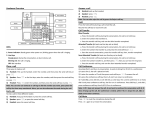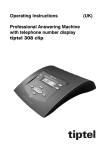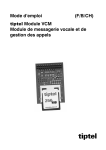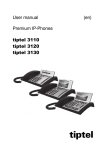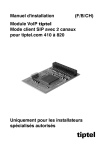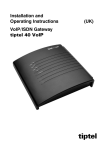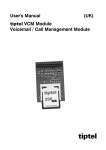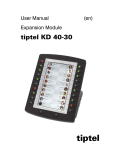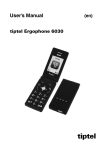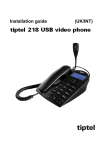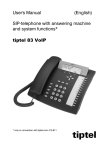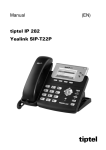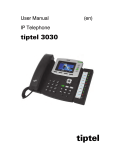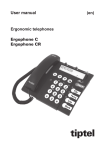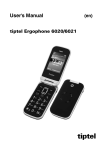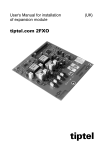Download this file
Transcript
User's Manual (UK) ISDN Telephone System tiptel.com 410 tiptel.com 810 tiptel.com 411 tiptel.com 811 tiptel.com 822 XT/Rack tiptel.comPact 42/82 IP 8 tiptel.comPact 84 Up4/Rack tiptel Table of Contents Table of Contents Table of Contents ............................................................................................ 3 Notes ............................................................................................................... 5 Directions for operating the telephone system ...........................................................5 First calls ......................................................................................................... 6 Internal call .............................................................................................................6 External call ............................................................................................................6 Inquiry call ..............................................................................................................7 Inquiry call with call transfer ...................................................................................7 Extension features .......................................................................................... 8 Call forwarding .......................................................................................................8 Configuration .................................................................................................. 10 Analogue extension .....................................................................................................10 Call waiting signal allowed .....................................................................................10 Call number identification ......................................................................................10 Functions ......................................................................................................... 11 When setting up the connection .................................................................................11 Select outgoing internal number ...........................................................................11 Pick-up....................................................................................................................11 Follow me ...............................................................................................................11 Speed dial ..............................................................................................................12 Completion of Call to Busy Subscriber (CCBS) ....................................................12 Completion of Call on No Reply (CCNR) ...............................................................13 During the call .............................................................................................................14 Call Waiting (CW) ...................................................................................................14 Malicious Call Identification (MCID) .......................................................................14 Hold ........................................................................................................................15 Conference .............................................................................................................15 Terminal Portability (TP) .........................................................................................15 Inquiry / switching between lines ...........................................................................16 Explicit Call Transfer ...............................................................................................17 Operating the answering machine ................................................................. 18 Remote access ............................................................................................................18 Remote access functions ............................................................................................19 Playback incoming message function ...................................................................19 Switching functions ................................................................................................19 Changing outgoing messages...............................................................................20 Message transfer function ......................................................................................20 Switch off device function ......................................................................................20 Remote activation of answering mode ......................................................................21 3 Remote dialling-in ........................................................................................... 21 Subscriber configuration via PC .................................................................... 22 Subscriber ....................................................................................................... 24 Settings...................................................................................................................24 Call forwarding .......................................................................................................25 Charge account ......................................................................................................26 Answering machine .....................................................................................................26 ICM ..............................................................................................................................26 General command summary .......................................................................... 27 Function codes, only for analogue terminals ................................................ 29 During the call ........................................................................................................29 Index ................................................................................................................ 30 4 Notes Notes We reserve the right to make changes to this User's Manual or the hardware described at any time and without prior notice. The current version of the User's Manual is also available as a pdf file on the Internet at www.tiptel.com. The texts and illustrations of this user's manual have been compiled with the utmost care. However, errors cannot be ruled out completely. The publisher can not be held liable for any incorrect information or consequences arising as a result. Important: This manual reflects the telephone system, release 7.xx. If necessary, perform an update. © 2010 Tiptel.com GmbH Business Solutions Ratingen. All rights reserved. Directions for operating the telephone system Before your make your first call, you should make yourself familiar with the symbols used in this User's Manual. In the User's Manual, the following symbols are used for programming the system or activating and deactivating features: Pick up receiver ...... Enter code digits and key sequences .. Enter special keys R key: Flash function Hang up receiver Note: Only tiptel.com 411, 811, 822XT/Rack, tiptel.comPact 42/82 IP 8 and tiptel.comPact 84 Up4/Rack support ISDN- and TIPTEL system-telephones. 5 First calls First calls Upon delivery, the automatic exchange connection is disabled within the telephone system. Dial the line prefix "0" for CO line access. If the “automatic exchange connection” feature has been activated, you can dial “”for an internal line, or wait for 10 seconds after picking up the receiver until you hear the internal dialling tone. You can then dial desired extension number. After 10 seconds, the telephone system automatically switches to the internal dialling tone. Internal call Analogue telephone 50: Pick up receiver. You hear the internal dialling tone. Dial internal subscriber number. You hear the ringing tone or the busy tone. Analogue telephone 51: Pick up receiver. You are connected with the internal subscriber. Place your call. Hang up both receivers. Termination of call. Analogue telephone 50: Pick up receiver. You hear the internal dialling tone. Dial line prefix. You hear the external dialling tone. Dial the phone number of the external subscriber. You hear the ringing tone or the busy tone. External subscriber: Pick up receiver. You are connected with the external subscriber. Place your call. Hang up receiver. Termination of call. External call 6 First calls Inquiry call Analogue telephone 50: Pick up receiver. You hear the internal dialling tone. Dial phone number. Signal to telephone 51. Analogue telephone 51: Pick up receiver. Place your call with telephone 51. Initiate inquiry call. You hear the internal dialling tone. Dial phone number. Signal to telephone 52. Analogue telephone 52: Pick up receiver. Place your call with telephone 52. Terminate inquiry. Place your call with telephone 51. Hang up all receivers. Termination of call. Inquiry call with call transfer Analogue telephone 50: Pick up receiver. You hear the internal dialling tone. Dial phone number. Signal to telephone 51. Analogue telephone 51: Pick up receiver. Place your call with telephone 51. Initiate inquiry call. You hear the internal dialling tone. Dial phone number. Signal to telephone 52. Analogue telephone 50: Hang up receiver. Analogue telephone 52: Pick up receiver. Active call between telephones 51 and 52. Hang up all receivers. Termination of call. 7 Extension features Extension features The following list describes the features provided for the different extensions. Note: Many of the features are displayed on ISDN terminals and can be enabled directly via speed dialling keys. Because of the huge diversity of terminals available on the market, operating instructions cannot be provided here. Please consult the User's Manuals of the appropriate terminals. Call forwarding Call forwarding is executed within the telephone system and can be configured individually for each extension. It is possible to forward calls to internal and external calling destinations. There are three authorisation levels for enabling call forwarding: no call forwarding permitted call forwarding permitted only to internal destinations call forwarding permitted to internal and external destinations The following examples assume that the call forwarding is set up on one’s own telephone in all cases. Call Forwarding Unconditional (CFU) Incoming calls are immediately routed to the programmed destination phone number. Your own terminal does not display a notification for the call. This setting is recommended for business trips, holidays, etc. Call Forwarding on Busy (CFB) Incoming calls are forwarded to another terminal if your own extension is busy. Note: In order for the CFB feature to work properly, it is absolutely essential to disable the "call waiting" feature at the appropriate terminal device(s). Call Forwarding No Reply (CFNR) Incoming calls are first signalled on your own terminal. If the call is not answered during this time, it will be forwarded to the call forwarding destination. 8 Extension features If call forwarding is enabled, it is indicated on the terminal by a special dialling tone that you will hear after picking up the receiver. Outgoing calls are possible from the terminal without restrictions. To enable the different types of call forwarding, the following key sequences must be entered: Call Forwarding Unconditional (CFU) off Call Forwarding Unconditional (CFU) on with destination phone number destination Call Forwarding No Reply (CFNR) off Call Forwarding No Reply (CFNR) on with destination phone number destination Call Forwarding on Busy (CFB) off Call Forwarding on Busy (CFB) on with destination phone number destination When programming an external destination number, the line prefix (as standard) must also be entered. The input is concluded by a positive acknowledgement tone or an error tone. The call forwarding always refers to the programmed outgoing MSN. ISDN telephones are programmed via the keypad or via individual menus using the appropriate ISDN services. Please consult the User's Manual of your ISDN terminals. 9 Configuration Configuration Analogue extension Call waiting signal allowed At analogue extensions, the call waiting signal is enabled or disabled with the following key sequences: Call waiting off Call waiting on The entry is confirmed by a positive confirmation tone. Note: If ISDN telephones are connected, this feature is managed by the terminal itself. To programme the calling line identification services at your terminals, please consult the User's Manuals for your ISDN telephone. Call number identification There are two types of calling line identification services: Calling Line Identification Presentation (CLIP) or Calling Line Identification Rectification (CLIR): Your own phone number is transmitted / not transmitted to the destination subscriber for outgoing calls. Connected Line Identification Presentation (COLP) or Connected Line Identification Restriction (COLR): When accepting an incoming call, the destination telephone number is transmitted / not transmitted to the caller who made this call. At analogue extensions, this feature can be enabled or disabled with the following key sequences: Phone number transmission off Phone number transmission on The entry is confirmed by a positive confirmation tone. If ISDN telephones are connected, this feature is managed by the terminal itself. To programme the calling line identification services at your terminals, please consult the User's Manuals for your ISDN telephone. 10 Functions Functions When setting up the connection Select outgoing internal number MSN Analogue telephone for subscribers 40, 41: Pick up receiver. You hear the internal dialling tone. Dial key sequence, MSN represents the desired outgoing internal number (for example 41). You hear a positive confirmation tone. Hang up receiver. End of setting. ISDN telephones are programme via individual menus. Please consult the User's Manual of your ISDN terminals. Pick-up When another telephone rings, you can take over the call with your own telephone (pick-up). Pick-up is available for internal and external calls. In order to pick up a call, the following key sequence has to be entered: Pick-up Requirement: The pick-up feature must be enabled for the subscriber who is to pick up the call. Follow me This function allows you to transfer the call forwarding of your internal number to the phone number of your current location. Press the following buttons to apply call forwarding to the other extension: Follow me (own phone number) Requirement: If calls are to be picked-up by a subscriber, it is first necessary to activate the follow-me option for this subscriber. 11 Functions Speed dial A speed dialling list is available for frequently used telephone numbers. Up to 100 phone numbers of up to 24 digits each can be stored. These phone numbers can be dialled by every subscriber. Speed dialling is carried out via the key sequence - . The keys represent the speed dialling index. It is possible to dial additional digits after the speed dialling number. To do this, simply enter the requested digits after the speed dialling number. If the automatic exchange connection feature has been activated and the handset is lifted, it is possible to switch to the internal dialling tone by entering the key sequence. Next, the requested speed dialling number can be entered. After 10 seconds, the telephone system automatically switches to the internal dialling tone. Please consult the "speed dialling" chapter in the installation guide for further information. Completion of Call to Busy Subscriber (CCBS) If the destination subscriber’s line is busy, the connection will be set up automatically as soon as the external or internal destination subscriber terminates his call. The CCNR feature must be enabled by the caller. When the destination subscriber hangs up, the caller receives a call signal. Upon picking up the receiver, the connection to the destination subscriber is established without any further dialling necessary. The automatic connection is then complete. Initiation of a CCBS depends on the kind of terminal used: If a DTMF dialling terminal is used, the automatic call-back can be enabled by entering the following key sequence(s): o enabling of CCBS: o disabling of CCBS: If an ISDN terminal is used and if the CCBS feature is supported, the automatic call-back feature can be enabled using a speed dialling key. For further information, please consult the User's Manual of the ISDN terminal. If an analogue terminal is used, you hear a positive confirmation tone as soon as the CCNR request has been registered within the telephone system. In the event of an error, you will hear an error tone. If the feature is not supported, you hear a negative confirmation tone. 12 Functions CCNR requests are deleted from the telephone system after 60 min. This period of time depends on the public exchange office if external subscribers are to be called. Requirements: In case of external call-backs the CCBS feature must be supported and enabled by your own network provider as well as the network provider of the called subscriber. Completion of Call on No Reply (CCNR) If the destination subscriber does not answer a call, the connection will be established automatically as soon as the destination subscriber has made another call. The CCNR feature must be enabled by the caller. When the destination subscriber hangs up, the caller receives a call signal. Upon picking up the receiver, the connection to the destination subscriber is established without any further dialling necessary. The automatic connection is then complete. Initiation of a CCNR depends on the kind of terminal used: If a DTMF dialling terminal is used, the automatic call-back can be enabled by entering the following key sequence(s): o enabling of CCNR: o disabling of CCNR: If an ISDN terminal is used and if the CCNR feature is supported, the automatic call-back can be enabled using a speed dialling key. For further information, please consult the User's Manual of the ISDN terminal. If an analogue terminal is used, you hear a positive confirmation tone as soon as the CCNR request has been registered within the telephone system. In the event of an error, you will hear an error tone. If the feature is not supported, you hear a negative confirmation tone. CCNR requests are deleted from the telephone system after 60 min. This period of time depends on the public exchange office if external subscribers are to be called. Requirements: In case of external call backs the CCNR feature must be supported and enabled by the caller’s network provider and the network provider of the subscriber called. 13 Functions During the call Call Waiting (CW) If a destination subscriber’s line is busy, this subscriber hears a call waiting signal as soon as a second call comes in. The destination subscriber can reject the waiting call. In this case, the calling subscriber hears the busy tone. The other possibility is that the destination subscriber accepts the waiting call, and the current call is placed on hold. If analogue terminals are used, waiting calls are handled as follows: Accept waiting call Accept call waiting and terminate current conversation Reject waiting call Forward caller (without accepting) Then enter target phone number. If ISDN terminals are used, waiting calls are accepted or rejected via corresponding menus. Please consult the User's Manual for your ISDN telephone. Malicious Call Identification (MCID) The MCID feature is used to identify malicious callers. The caller’s number is stored in the operator’s network and notified on request. Call tracing is possible during an active connection and within 20 sec thereafter. It is necessary to apply for the enabling of this feature with the network operator. Charges are levied for the use of this feature. If ISDN telephones are connected, this feature is managed by the terminal itself. For programming this feature at an ISDN terminal, please consult the User's Manual for your ISDN telephone. If analogue terminals are used, the feature can be enabled via the following key sequences: Trace subscriber or hang up Requirement: The feature MCID must have been enabled by the network operator. 14 Functions Hold There are two ways to place incoming external calls on hold: either externally within the exchange or internally within your telephone system. The setting in which way calls are put on hold was performed by the installer of your telephone system. One of the differences is that if a call has been placed on hold within the exchange, the external caller hears the music-on-hold selected by the network provider. During the hold within your telephone system, your own music-on-hold is heard. Conference When a subscriber has a call on hold and an active call, he/she can set up a threeway conference. In this case, the three subscribers will be interconnected within the telephone system. A maximum of four internal three-way conferences is possible. If the subscriber initiating the conference hangs up, all connections will be terminated. If one of the other subscribers hangs up, the connection between the two other subscribers remains active. If analogue terminals are used, a three-party conference can be initiated via the following key sequence: Initiate conference If ISDN telephones are connected, this feature can be enabled by the terminal itself via speed dialling keys. For enabling this feature, please consult the User's Manual for your ISDN telephone. In case of two external subscribers, the conference can be initiated within the exchange, provided that both have been switched via the same S0 connection. It should be noted in this regard that additional charges can be levied by the network provider for a three-party conference within the exchange. Terminal Portability (TP) If you wish to continue an active call from another part of the building, you can park the call within the telephone system and remove it from another extension. After initiating parking, you can disengage parking within three minutes at another extension and thencontinue the call with the person you are calling. To programme this feature at an ISDN terminal, please consult the User's Manual for your ISDN telephone. If analogue terminals are used, this feature can be initiated as follows: parking a call: two-digit parking number 15 Functions Remove a call from parking: number two-digit parking Inquiry / switching between lines This feature gives you the option of putting an internal or external call on hold in order to place an inquiry call. During the time of inquiry, the subscriber hears musicon-hold. After termination of your inquiry call, you can resume the first call. Initiation of an inquiry depends on the kind of terminal used: with ISDN terminals via the -key or via a menu provided and use of the speed dialling keys with DTMF dialling terminals by pressing the -key Analogue telephone 50: Pick up receiver. You hear the internal dialling tone. Dial phone number. Signal to telephone 51. Analogue telephone 51: Pick up receiver. Place your call with telephone 51. Initiate inquiry call. You hear the internal dialling tone. Dial phone number. Signal to telephone 52. Analogue telephone 52: Pick up receiver. Place your call with telephone 52. Two-line conversation with hold. Place your call with telephone 51. Terminate call with telephone 51. Place your call with telephone 52. Hang up all receivers. Termination of call. 16 Functions Explicit Call Transfer This feature gives you the options of connecting two calls. For example, if you have an active call and a call on hold, you can interconnect both subscribers. Analogue telephone 50: Pick up receiver. You hear the internal dialling tone. Dial phone number. Signal to telephone 51. Analogue telephone 51: Pick up receiver. Place your call with telephone 51. Initiate inquiry call. You hear the internal dialling tone. Dial phone number. Signal to telephone 52. Analogue telephone 52: Pick up receiver or – for call transfer without prior notice – proceed with the next step. Place your call with telephone 52. Analogue telephone 50: Hang up receiver. Connection between telephones 51 and 52. 17 Operating the answering machine Operating the answering machine Note: The function answering machine is available only if tiptel VCM-module is installed. The installation and configuration of answering machines are described in the installation manual. The operating of the answering machines can be done from a local phone by the code or by remote access from anywhere in the world using the keypad on a Dual-tone Multiple Frequency (DTMF) touchtone telephone. You need a personal access code to access the phone remotely. You can set your personal remote access code as described in "Settings". Remote access Call your personal answering machine. Internally available under 930 from the assigned subscriber. Otherwise, call the subscriber using the extension/direct dial number. You hear the current announcement. Enter the remote access code via the telephone keypad. If you make a mistake delete entry using the * key and start again. A voice message confirms recognition of each digit. To confirm the entry press the # button. If the correct code is detected your VCM module 14 notifies you via a voice message. If the code is incorrect, the device terminates the connection. Note: If you have activated the QRC function (refer to “Installation Manual of your tiptel telephone system”) for the call number from which you are calling, your personal answering machine answers directly with the voice message. Then you do not have to enter your remote access code. Start the desired function by entering the relevant digit (e.g. Number 2 to playback all new incoming message). Each digit is confirmed. Press digit 8 to end a function. The current function ends. End remote access by pressing star and hash in succession. 18 Operating the answering machine Remote access functions Playback incoming message function To playback all messages Press 3. The playback starts with the oldest recording. To playback all messages Press *3. The playback starts with the newest recording. To playback new messages Press 2. Starts playback of recordings that have not yet been heard beginning with the oldest message. To playback new messages Press *2. Starts playback of recordings that have not yet been heard beginning with the newest message. Repeat Press 5 during playback. The last three seconds are repeated. To pause playback Press 8. Playback is paused. To continue playback Press 5. Playback is continued from where it was paused. Skip Press 4 for back or 6 for forwards during playback. The message you are listening is skipped or repeated. Repeat Press 2 during playback. Playback is paused and the caller’s number is announced (requires call number transfer being permitted by the network provider). To delete the current message Press 7 during playback. The current incoming message is deleted. To delete all messages Press * and 7 in succession. All incoming messages are deleted. Switching functions To switch message transfer on/off Press * and 4 in succession. The current status "on" or "off" is announced. Important note: The type of message forwarding (e.g. SMS or call) matches the most recent setting in the web interface. ... Change between messages Dial number 7 and the desired message 0 … 9 in succession. The selected outgoing message is played back for checking. The next caller is greeted with this message. 19 Operating the answering machine Changing outgoing messages ... Change the messages Dial number 9 and the desired message 1 … 9 in succession. Your personal answering machine requests you to speak. If you have called the MSN of an answering machine you can only change your own messages 8 and 9! Record an outgoing message. For an outgoing message with incoming message option After recording the outgoing message press 8. The announcement is played back for checking. At the end you hear one signal tone. For a announcement without incoming message option (announcement only): After recording the announcement press #. The announcement is played back for checking. At the end you hear two signal tones. or Message transfer function Change the destination call number for message forwarding Press buttons * and 9 in succession. The current destination call number is announced. A request to enter a new target call number then follows. Enter the new target call number. Each digit is confirmed. To delete the target call number press the * button. The destination call number is deleted. To accept the target call number, press the # button. The new target call number is played back for checking. Switch off device function Switching answering mode off Press * and 0 in succession. Your personal answering machine is deactivated and will not answer any more calls. 20 Remote dialling-in Remote activation of answering mode Call the call number of your personal answering machine (MSN). After 50 seconds the device answers with a beep. Enter remote access code via the telephone keypad and accept by pressing the # button. The announcement is played for checking. The device can be operated remotely (e.g. to record a announcement). After terminating the remote access your personal answering machine is ready and will answer calls. Note: The remote activation option requires that you have previously entered a remote access code in your telephone system for the MSN called and that you have switched on the “Remote activation” function (refer to the “Installation Manual of your telephone system”). Note: If you call the device from a call number stored as a “QRC” (refer to “Installation Manual of your telephone system”) in your telephone system and the device is switched off, it answers immediately with the usual voice message. By entering you can now remotely switch your personal answering machine on at any time. You receive a voice confirmation (“answering mode on”). Remote dialling-in It is possible to access your telephone system from a remote location. In this case, you are either identified by means of the outgoing phone number sent or by entering a PIN code. It is also possible for the telephone systems to carry out a call-back. Once connected to the telephone system, you may use all configuration options, i.e. it is possible to modify call forwarding. Not only after a call-back but also after the direct dialling-in, it is possible to select a CO-line and to directly set up a connection via the telephone system to other external subscribers (call-back, call-through). This helps to reduce call charges and it is possible, for example, to hold a telephone call on your company’s cost centre. This can be helpful to distinguish private and business calls for tax purpose. Contact your system administrator / telephone system installer if this function should not be activated. He can, for example, activate your mobile phone number or assign a PIN. 21 Subscriber configuration via PC Subscriber configuration via PC It is also possible to configure the subscriber’s settings via the PC. For this you need a username, password and to connect a PC equipped with a network connection to the tiptel TK device. For the configuration please start your Internet browser and enter the telephone system’s IP address or the network identifier in the address bar. The factory settings are "192.168.34.100". User name and password an a different IP address (when applicable) will be provided by your system administrator or the person installing your telephone system. The configuration in the delivery status (factory settings) is described below. Example: Subscriber "Analog50" wishes to modify his configuration. The user name is pre-set to "Analog50". No password is used. 22 Subscriber configuration via PC After logging in, the following web page is displayed: 23 Subscriber Subscriber Settings Automatic exchange connection After picking up the receiver, the telephone system will automatically perform a standard exchange connection, i.e. the telephone system imperceptibly dials "0". If a free CO line is available, you will immediately hear the external dialling tone. If all external lines assigned to the subscriber are busy, you hear an internal busy tone. An automatic exchange connection is only executed for the first connection attempt. For setting up further connections – e.g. for an inquiry call – the internal dialling tone is heard first. If a further external connection is to be made, the exchange must be dialled. If the “automatic exchange connection” feature has been activated, you can dial “” for an internal line, or wait for 10 seconds after picking up the receiver until you hear the internal dialling tone. You can then dial desired extension number. After 10 seconds, the telephone system automatically switches to the internal dialling tone. Automatic exchange connection is also executed if no exchange authorisation is available. This is necessary in order to ensure that emergency phone numbers can be dialled. As soon as additional digits that do not belong to an emergency number are dialled, the connection is terminated. Requirements: The "automatic exchange connection" feature must be enabled. The required exchange authorisation must also be available. Pick-up Use this menu to define whether an incoming call may be picked up by another subscriber. Select the “answering machine” setting if you wish to operate an answering machine at this extension. You are now able to pick up the call even after it has already been answered by the answering machine. Follow me This function allows you to transfer the call forwarding of your internal number to the phone number where you currently are. Press the following buttons to realise call forwarding to the other extension: (individual phone number) 24 Subscriber Password After calling up the configuration menu for a subscriber, you have to enter a user name (subscriber name) and a password. Enter the desired password here. Outgoing number With an outgoing call your telephone system gives information to the exchange which number (MSN) is to be uses to establish the call. Applicable charges will be assigned to that MSN. In case CLIP has been activated that MSN will also be displayed at the other party's phone. Is that MSN unknown to the exchange usually the basic number will be used. Some exchanges - when ordered - will also pass on unknown numbers as CLIP information. In such a case you are free in programming any number you like. If you do not want to change the presets performed by the administrator just leave that field empty. Call forwarding Call forwarding is executed within the telephone system and can be configured individually for every subscriber. It is possible to forward calls to internal and external calling destinations. A maximum of two calls can be programmed for forwarding in succession within the telephone system. An external phone number must always contain the 0 for exchange connection. Note: With following examples it is assumed that the call forwarding is set up on one’s own telephone in all cases. Call Forwarding Unconditional (CFU) Incoming calls are immediately routed to the call forwarding destination. Your own terminal does not display a notification for the call. This setting is recommended during business trips, holidays, etc. Call Forwarding on Busy (CFB) Incoming calls are forwarded to another extension when your terminal is busy. Call forwarding no reply (CFNR) In this case, the incoming call is indicated on your terminal for a specific period of time. If the call is not answered during this time, it will be forwarded to the call forwarding destination. It is possible to enable call forwarding at the individual terminals (see User's Manual for your ISDN telephone). 25 Subscriber Charge account You can see the current credit on your charge account here. Answering machine Note: This menu is only available with an installed tiptel VCM-Module. If your administrator has made an answering machine available to you, you can configure it here. For detailed information please refer to the “tiptel VCM-Module Callmanager/Voicemail User's Manual”. ICM Note: This menu is only available with an installed tiptel VCM-Module. If your administrator has made an answering machine available to you, you can open the current summary of your ICM here and play them back directly via the media player on your PC. For detailed information please refer to the “tiptel VCM-Module Callmanager/Voicemail User's Manual”. 26 General command summary General command summary Select outgoing internal number internal number Completion of Call on No Reply on (CCNR) Completion of Call on No Reply off (CCNR) Call forwarding always off Call forwarding always on destination Log on to a group (Only with group mode "dynamic) nnn Log off from a group (Only with group mode "dynamic) nnn Call forwarding always on (follow me) own phone number Room monitoring PINnnn (nnn=Group number) (nnn=Group number) (PINuser room monitoring, n=Extension) PINnnn Hands-free (PINuser hands-free n=extension) nnn Announcement (n=Extension) Phone number transmission off Phone number transmission on Call number transfer for a call Completion of call to busy subscriber on (CCBS) Completion of call to busy subscriber off (CCBS) Call waiting off Call waiting on 27 General command summary Pick-up destinationed exchange connection via external s0 (Important with FXO- and/or VoIP-Module) Call forwarding on no reply off Call forwarding on no reply on destination Call forwarding when busy off Call forwarding when busy on Ziel Speed dial (from global speed dial directory within telephone system), 100 target numbers 00 - 99 Telephone book (only with System / ISDN telephones) Pick-up answering machine Play music on hold Assigning the cost centre (cost centre digit number) (cost centre) (destination call number) 28 Function codes, only for analogue terminals Function codes, only for analogue terminals During the call Hold / inquiry Reject waiting call End active call and switch to call waiting Put active call "on hold", accept call waiting, or switch to call on hold Start conference between held and active call Forward call waiting (without accepting it) Trace subscriber (MCID) Parking a call nn nn = 2 digit park number nn Reconnecting a parked call nn = 2 digit park number Note: If ISDN telephones are connected, these features are managed by the terminal itself. For programming the calling line identification services at your terminals, please consult the user’s manuals of your ISDN telephone. 29 Index A F Answering machine ........................... 26 Automatic exchange connection ....... 24 First calls .............................................. 6 Follow me .................................... 11, 24 Function when setting up the connection ..... 11 Functions ........................................... 11 Functions during the call ................... 14 C Call ..................................................... 14 Call back on busy .............................. 12 Call back on no reply ......................... 13 call forwarding on busy ...................................... 8, 25 Call forwarding ............................... 8, 25 no reply .......................................... 25 unconditional.............................. 8, 25 Call forwarding on no reply.................. 8 Call tracing ......................................... 14 Call transfer ........................................ 17 Call waiting ........................................ 14 Call waiting signal allowed ................ 10 Caller’s number ................................. 19 CCBS ................................................. 12 CCNR ................................................. 13 CFB ................................................ 8, 25 CFNR ............................................. 8, 25 CFU................................................ 8, 25 Charge account ................................. 26 CLIP ................................................... 10 COLP ................................................. 10 Command summary analogue terminals ........................ 29 Command summary general ........................................... 27 Conference ........................................ 15 Configuration ..................................... 10 analogue extension ........................ 10 via PC ............................................. 22 H Hold ................................................... 15 I ICM .................................................... 26 Inquiry ................................................ 16 Inquiry call ............................................ 7 Inquiry call with call transfer ................. 7 Internal call ........................................... 6 M MCID .................................................. 14 N Notes ................................................... 5 O OGM with ICM ................................... 20 OGM without ICM .............................. 20 Operation directions ............................ 5 outgoing internal number .................. 11 Outgoing number .............................. 25 P Parking ............................................... 15 Password ........................................... 25 Pick-up ......................................... 11, 24 E Extension features ............................... 8 External call.......................................... 6 30 R S Remote access .................................. 18 Remote access code......................... 18 Remote access functions .................. 19 Remote activation .............................. 21 Remote deletion................................. 19 remote dialling-in ............................... 21 Skip .................................................... 19 Speed dial .......................................... 12 Switching between lines .................... 16 T Three-way conference ....................... 15 31 Tiptel.com GmbH Business Solutions Halskestraße 1 D - 40880 Ratingen Tel.: 0900 100 – 84 78 35* Vanity Tel.: 0900 100 – TIPTEL* Internet: www.tiptel.de International: Internet: www.tiptel.com *(gebührenpflichtig) Tiptel GmbH Tenschertstraße 5 A - 1230 Wien Tel.: Fax: E-mail: Internet: 01 - 616 78 71 01 - 616 78 71 - 22 [email protected] www.tiptel.at Tiptel AG Bahnstrasse 46 CH - 8105 Regensdorf Tel.: 044 - 843 13 13 Fax: 044 - 843 13 23 E-mail: [email protected] Internet: www.tiptel-online.ch Tiptel B.V. Camerastraat 2 NL – 1322 BC Almere Telefoon: 0900 – BELTIPTEL of 0900 – 2358478 (niet gratis) Fax: 036 – 53 678 81 E-mail: [email protected] Internet: www.tiptel.nl Tiptel NV Leuvensesteenweg 510 bus 4 B – 1930 Zaventem Telefoon: 0903 99 333 (1,12 Euro / min.) Fax: 02 714 93 34 E-mail: [email protected] Internet: www.tiptel.be Tiptel sarl 23, avenue René Duguay-Trouin F – 78960 Voisins-Le-Bretonneux Tél. : 01 / 39 44 63 30 Fax : 01 / 30 57 00 29 e-mail : [email protected] Internet : www.tiptel.fr (UK) 06/2010
































